Amedeo Modigliani
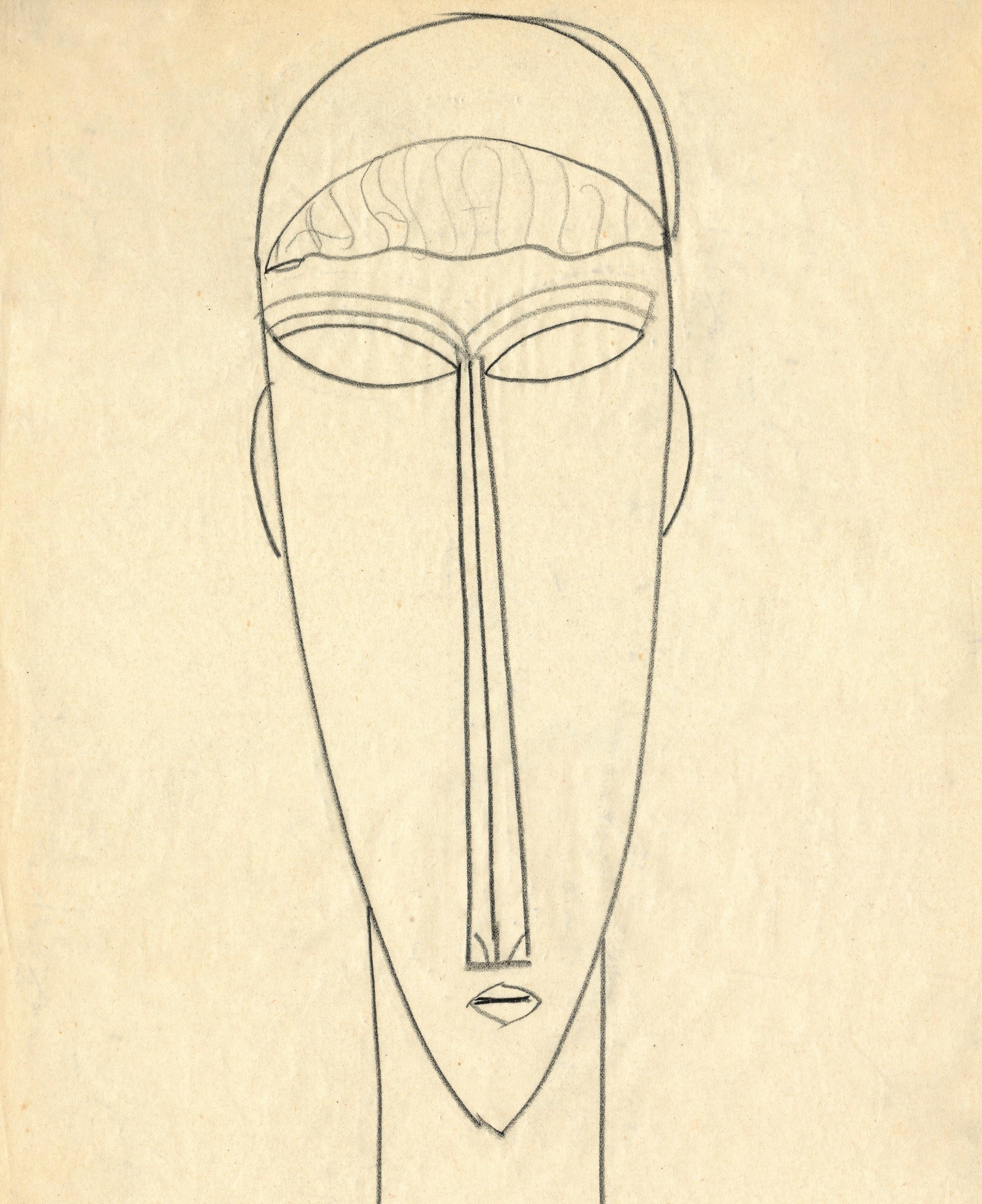
January 2024
1908 1912
January 2024 1908 1912 Amedeo Modigliani Early Drawings from the Dr. Paul Alexandre Collection Brussels 1 rue aux Laines, 1000 Brussels noemie@agnewsgallery.com London 6 St. James’s Place, London, SW1A 1NP anna@agnewsgallery.com www.agnewsgallery.com
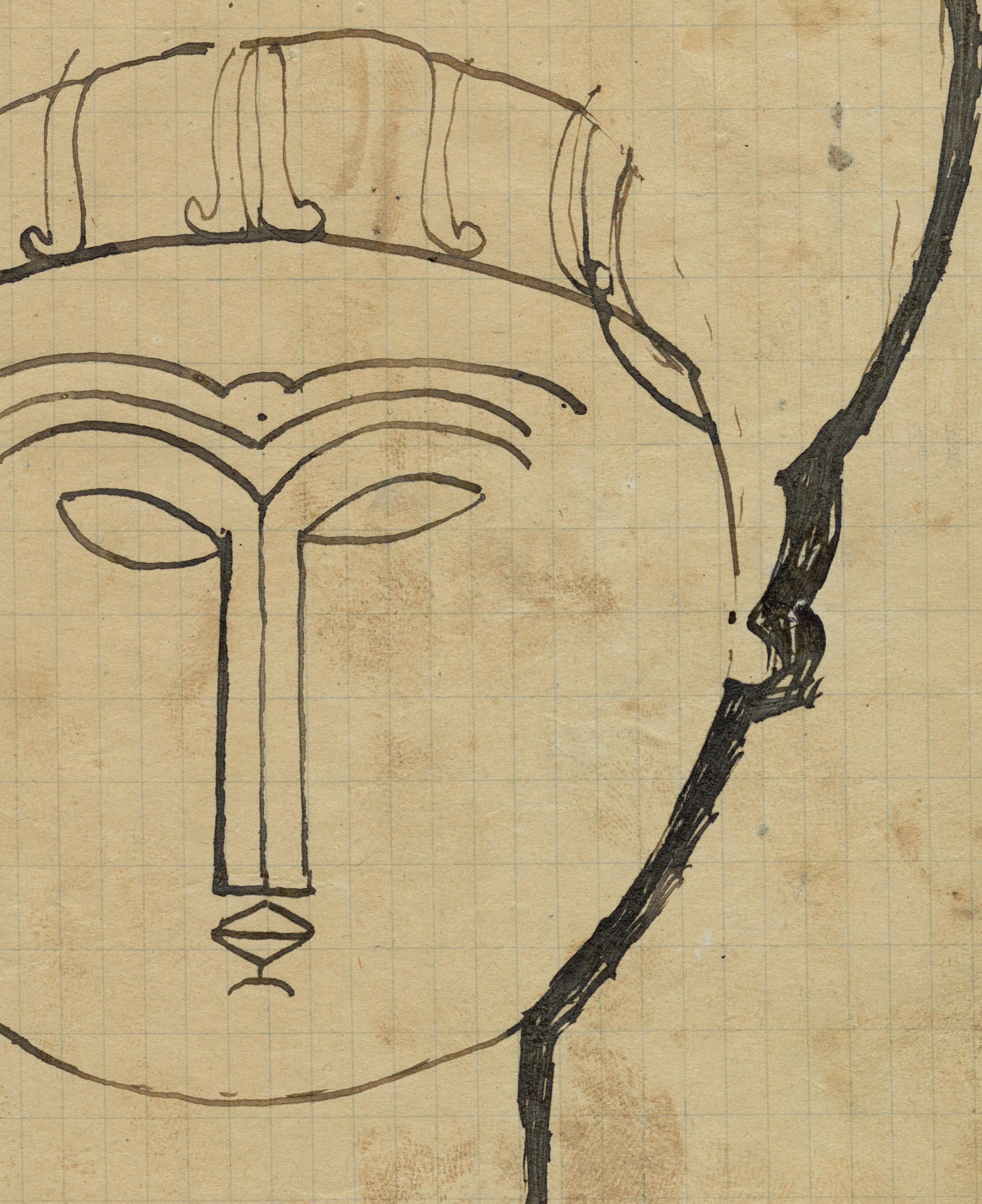
Happiness is an angel with a solemn face.
Amedeo Modigliani
Dear Friends,
As dealers who see our role more as the courier of artworks between their pasts and futures, it’s no small dream to handle pieces that have been given or sold directly by the artist to a collector or patron, and then held safe by the latter’s family and descendants. To deal with such works is to take on the responsibility of upholding an unbroken lineage and connecting it for the first time to a new home and legacy.
Such is the responsibility we feel in working with the drawings of Amedeo Modigliani presented in this catalogue. These fine works come from an intimate source, having originated in the collection of Dr. Paul Alexandre, the great friend and patron of “Modi,” as Paul and his brother Jean nicknamed the great artist. Between 1907, a year after the painter’s arrival in Paris, and 1914, when Paul was called to service in the first World War, the two became close friends, and Paul amassed a remarkable collection of nearly five hundred drawings by Modigliani, almost half the total of his recorded drawings. Paul and Amedeo were of the same generation – the same age, in fact – and they became fast friends. In addition to supporting the painter, serving as his only buyer during those early, lean years, Paul also received Amedeo’s confidences – his aspirations, the ideas behind his bold pictorial experiments – and begged the artist not to destroy his notebooks and studies on paper. Paul was fascinated by his friend’s artistic genius. As Paul’s son, Noël, would later say: “The deep friendship between my father and Modigliani stemmed from the fact that they both believed that the artist’s duty was to say something essential for humanity. This vision of man is particularly evident in Modigliani’s drawings. He ennobled everything he touched with his brush or pencil, showing the almost divine side of human nature.”
In January 1920, just over a year after the Armistice, Modigliani died of tuberculosis, before Paul was able to see his friend again. For a long time thereafter, Paul was among the few figures pushing for wider recognition of his friend’s work. His own collection was not unknown, and amateurs and scholars consulted it on several occasions, but Dr. Alexandre held the works close to his chest while planning a catalogue that would not be published until after his death: The Unknown Modigliani (1993, Fonds Mercator).
In framing his collection, Alexandre had been particularly keen to correct the legend, which arose after Modigliani’s death, that his friend was a cursed artist. In fact, as Paul knew, Modigliani was charming, refined, naturally distinguished, and reserved without being arrogant. Although he fought courageously for twenty years against tuberculosis and had few means of subsistence, the artist was also lyrical and amusing, without ever indulging in extremes, as the popular mythology would have it.
In the pages that follow, we will have ample chance to discuss the beautiful drawings published in the present catalogue. Most of the drawings offered here include a small perforation on their margin, indicating that they were taken from a sketchbook, explaining the consistency of their paper type and sheet dimension. All these works uncover Modigliani’s intimate thought processes. They are the pages on which he experimented, and where he embarked on his search for the perfect and ideal image. Gazing upon these ravishing studies of theatrical inspiration – from his early nude life drawings to his portraits, his sculptural heads, and his caryatids of breathtaking purity, right down to the smallest and quickest of his sketches – one feels that Modigliani is always present, totally and marvelously, with all the Apollonian force of his radiant genius.
Eric & Noémie
The purpose of art is to fight against obligations. Amedeo Modigliani
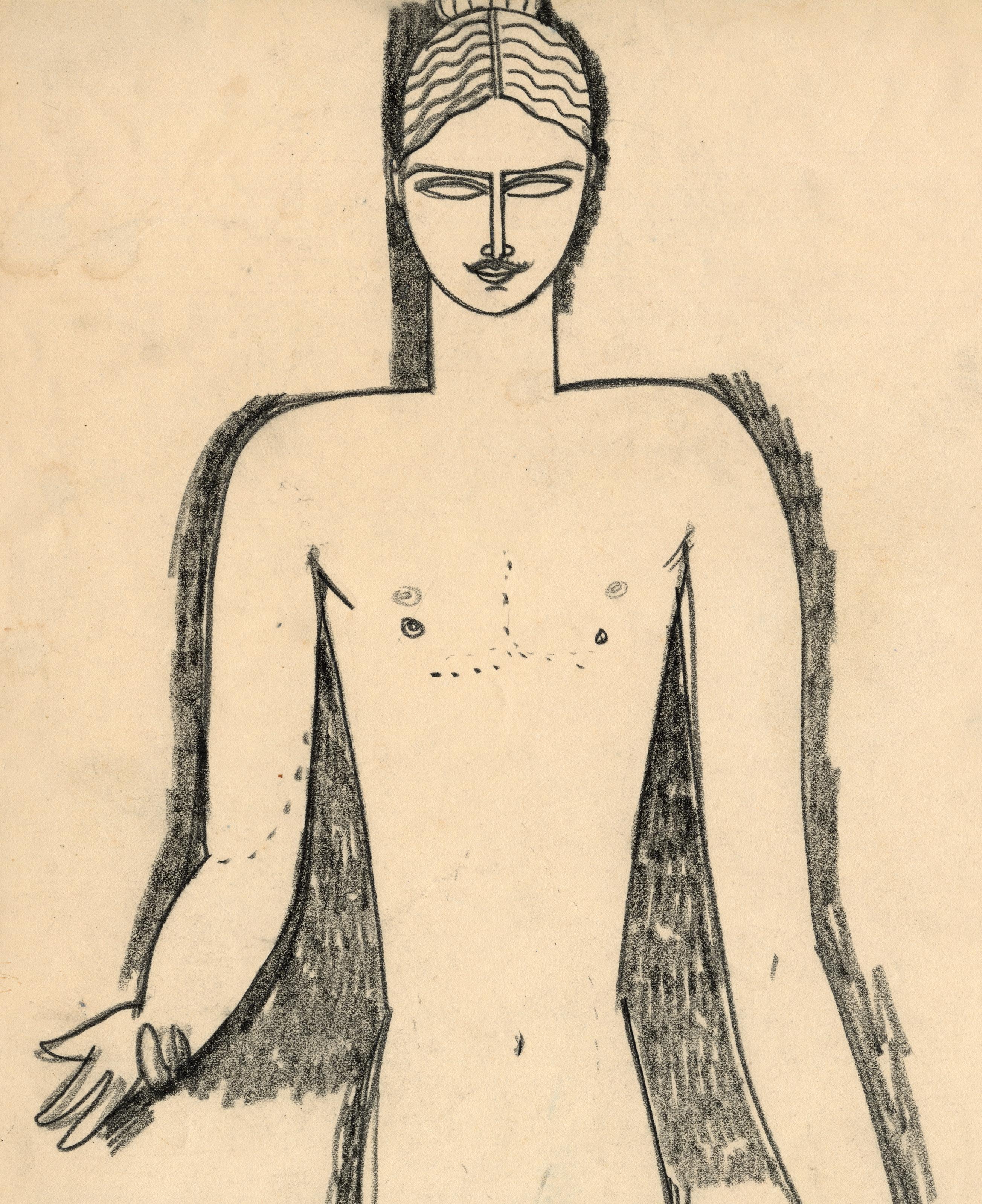
Drawings
The present works come from the heirs of Dr. Paul Alexandre, an “unimpeachable provenance of an intact collection,” as Jeanne Modigliani, the artist’s daughter, described it. Large part of the collection has been published by Paul’s son, Noël in Modigliani Inconnu. Dessins de la Collection Paul Alexandre (Fonds Mercator, 1993), and has been exhibited in major museums, such as The Royal Academy of Arts in London, the Palazzo Grassi in Venice and the Museo Reina Sofia in Madrid.
Furthermore, a certificate of provenance will accompany each work, attesting to the complete succession of ownership, beginning with Dr. Paul Alexandre’s purchase of the works from Modigliani and continuing to the present day.
1 Amedeo Modigliani 1884
Livorno – Paris 1920
Femme nue de face, les mains derrière la tête
Pencil on grid paper, from a notebook, ca. 1908
With Dr. Paul Alexandre stamp, and the number 14
Sheets 430 x 278 mm
Reference Noël Alexandre, Modigliani inconnu. Témoignages, documents et dessins inédits de l’ancienne collection de Paul Alexandre, 1993, ill. 280, p. 318, cat. 283
Exhibition Modigliani inconnu. Dessins de la Collection Paul Alexandre, 1993-1996; Venice, Palazzo Grassi; London, The Royal Academy of Arts; Cologne, Ludwig Museum; Bruges, Kunstcentrum St. Jan; Tokyo, The Ueno Royal Museum; Lisbon, Culturgest; Madrid, Museo Reina Sofia; Montreal, Musée des Beaux-Arts; Rouen, Musée des Beaux-Arts; Modigliani Unmasked, New York, Jewish Museum, 2017-2018, ill. p. 53
Provenance Dr. Paul Alexandre, Paris (purchased directly from the artist), thence by descent
During his early years in Paris, Modigliani regularly attended live model drawing sessions. Here, Modigliani’s sculptural rendering of the model and her pose, with her arms crossed at the back of her head, evoke an early dialogue with the art of Pablo Picasso. Picasso and Modigliani had known each other since 1906, having met that year either on the Butte Montmarte or at the Lapin Agile. Modigliani discovered Picasso’s paintings through the dealer Clovis Sagot, when the Spanish artist was moving from his blue and pink periods to a new body of work, one exemplified by his renowned Portrait of Gertrude Stein , which he completed in 1906. Picasso’s reduction of Stein’s visage to its essential forms was born out of his exchanges with Henri Matisse and André Derain, who were then playing pioneering the appropriation of African and Oceanic sculpture for Western painting. Only a few months later came Picasso’s Les Demoiselles d’Avignon, whose central figure bears an uncanny resemblance to Modigliani’s Femme nue de face, les mains derrière la tête
Between the autumn of 1906 and the winter of 1907, Modigliani could have seen Picasso’s imposing nudes, with their powerful volumetric forms and their faces
reduced to masks. Yet according to Pierre Daix, “even if two of Modigliani’s drawings [from] 1906-1907 may resemble Picasso’s female drawings of the time, I believe that to look for precise imitations would be a mistake, as Modigliani expressed his originality in the clearest terms from the outset. What he most likely drew from Picasso, as from Matisse’s figures […] was what I would call the permission to break the rules, to ‘do things badly’, as Picasso used to say. […]” 1
Femme nue de face, les mains derrière la tête expresses a remarkable sense of sculptural form, in keeping with the non-European arts that the entire avantgarde, seeking a renewal of aesthetic vitality, hungrily appropriated. This drawing also confirms the strength of these works on paper, which, more than his sketches or studies, foreshadow the sculptural power of Modigliani’s mature period, as well as the marvelous suppleness of his elongated nudes.
1. Pierre Daix, “Picasso et Modigliani” in Modigliani. L’ange au visage grave, Paris, Musée du Luxembourg, 2002-2003, p. 63-70: 65-66. See also Juliette Pozzo, “Modigliani – Picasso: Two visions of Primitivism”, in Modigliani. The Primitivism Revolution, Vienna, Albertina, 2022, p. 31-37.
8
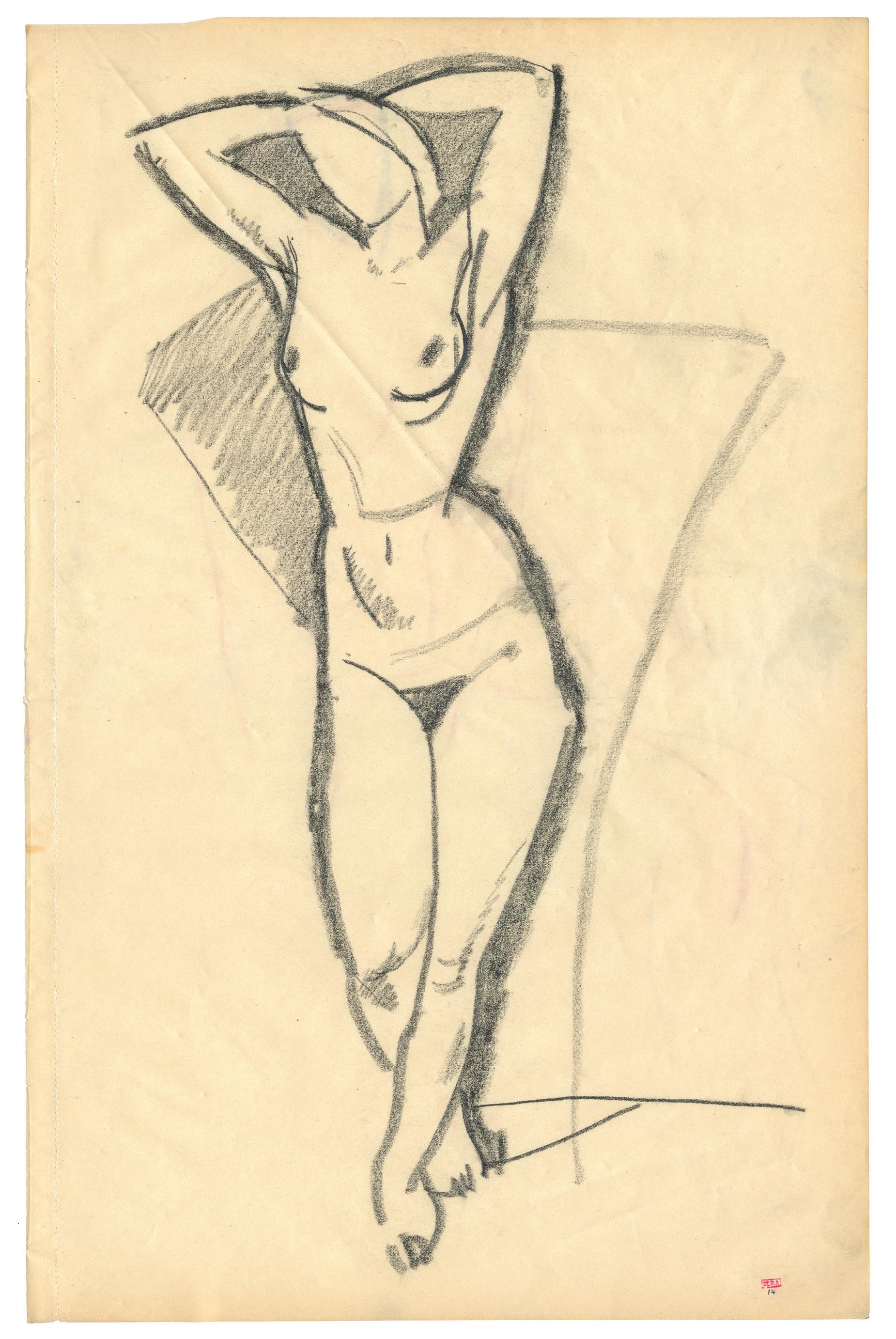
9
Amedeo Modigliani
1884 Livorno – Paris 1920
2 Femme nue de trois quarts
Pencil on wove paper from a notebook, ca. 1908
With Dr. Paul Alexandre stamp, and the number 17
Sheets 430 x 278 mm
Reference Noël Alexandre, Modigliani inconnu. Témoignages, documents et dessins inédits de l’ancienne collection de Paul Alexandre, 1993, ill. 285, p. 320, cat. 252
Exhibition Modigliani inconnu. Dessins de la Collection Paul Alexandre, 1993-1996; Venice, Palazzo Grassi; London, The Royal Academy of Arts; Cologne, Ludwig Museum; Bruges, Kunstcentrum St. Jan; Tokyo, The Ueno Royal Museum; Lisbon, Culturgest; Madrid, Museo Reina Sofia; Montreal, Musée des Beaux-Arts; Rouen, Musée des Beaux-Arts
Provenance Dr. Paul Alexandre, Paris (purchased directly from the artist), thence by descent
3 Esquisse de tête et de buste d’une femme nue de profil
Pencil on wove paper from a notebook, ca. 1908
With Dr. Paul Alexandre stamp, and the number 10
Sheets 430 x 275 mm
Reference Noël Alexandre, Modigliani inconnu. Témoignages, documents et dessins inédits de l’ancienne collection de Paul Alexandre, 1993, ill. 284, p. 320, cat. 254
Exhibition Modigliani inconnu. Dessins de la Collection Paul Alexandre, 1993-1996; Venice, Palazzo Grassi; London, The Royal Academy of Arts; Cologne, Ludwig Museum; Bruges, Kunstcentrum St. Jan; Tokyo, The Ueno Royal Museum; Lisbon, Culturgest; Madrid, Museo Reina Sofia; Montreal, Musée des Beaux-Arts; Rouen, Musée des Beaux-Arts
Provenance Dr. Paul Alexandre, Paris (purchased directly from the artist), thence by descent
We know from Paul Alexandre that Modigliani was a regular attendee of drawing classes such as those given at the Académie Ranson in Montmartre, practicing with live models during the years after his move to Paris, particularly around 1908. In these sessions, the model would remain in the same pose for ten or fifteen minutes, giving Modigliani time to execute several drawings. In his imaginative variations on the theme of a single pose, Modigliani’s speed of mark-making and the precision of his line, as well as his composure and boldness in composition, make these drawings much more than mere studies.
Viewing the rapid tracings of these drawings, one can follow the artist’s hand and witness his determination to capture a pose with immediacy and clarity. Here, he focuses our attention instead on a single part of the
body, as if by photographic zoom. In these drawings Modigliani sought to convey technical know-how, though in doing so he expressed a particular aesthetic sensitivity. The Modigliani drawings in Dr. Alexandre’s collection refute the legend built up over thirty years by the critic André Salmon, in which a caricature of fiery genius sprang like lightning from Modigliani’s exaltation of drugs and absinthe. Indeed, in the rapid outline of these drawings we find a sure hand and a sober determination. Esquisse de tête et de buste d’une femme nue de profil (Sketch of the Head and Bust of a Nude Woman in Profile) is a perfect illustration of this intense research; on the reverse of the page is the impression another drawing, Femme nue de profil, appuyée sur la jambe gauche, which for years was folded in with the first sheet.
10

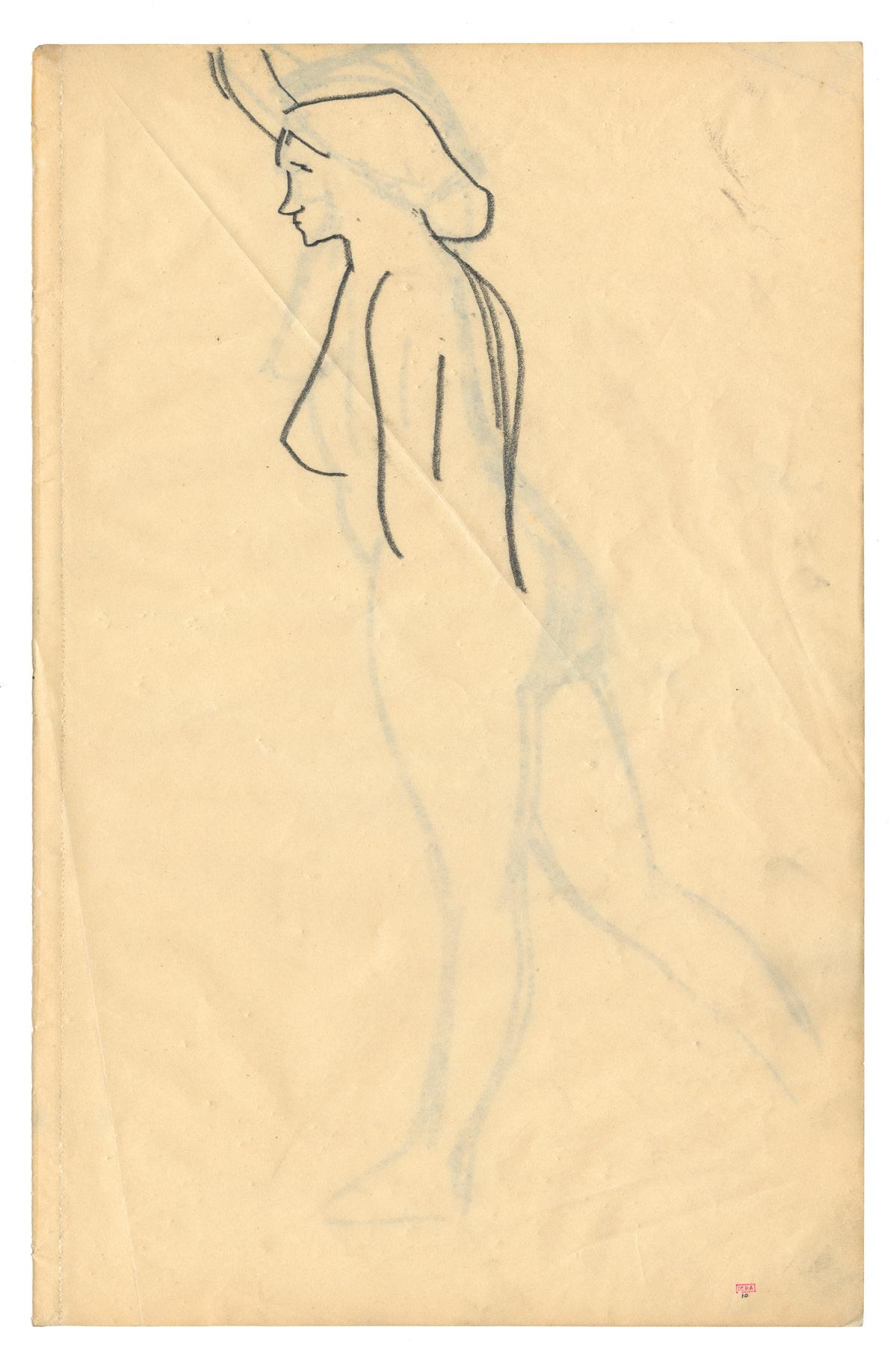
11
4 Amedeo Modigliani
1884 Livorno – Paris 1920
L’Amazone, tête et haut de buste de trois quarts gauche
Pencil on grid paper, from a notebook, 1909
With Dr. Paul Alexandre stamp, and the number 4.24
Sheets 208 x 130 mm
Reference Noël Alexandre, Modigliani inconnu. Témoignages, documents et dessins inédits de l’ancienne collection de Paul Alexandre, 1993, ill. 416, p. 425, cat. 338
Exhibition Modigliani inconnu. Dessins de la Collection Paul Alexandre, 1993-1996; Venice, Palazzo Grassi; London, The Royal Academy of Arts; Cologne, Ludwig Museum; Bruges, Kunstcentrum St. Jan; Tokyo, The Ueno Royal Museum; Lisbon, Culturgest; Madrid, Museo Reina Sofia; Montreal, Musée des Beaux-Arts; Rouen, Musée des Beaux-Arts; Modigliani Unmasked, New York, Jewish Museum, 2017-2018, ill. p. 133
Provenance Dr. Paul Alexandre, Paris (purchased directly from the artist), thence by descent
The present work is a beautiful preparatory drawing from one of Modigliani’s most famous portraits , L’Amazone. Before 1914, Modigliani’s drawings evinced a certain spontaneity that his paintings lacked. Letters from Jean Alexandre, the brother of Dr. Paul Alexandre, show that Modigliani had his models do many poses for long periods, indifferent to the possibility of tiring them out, and that he promptly destroyed any works with which he was not fully satisfied. “I could hardly prevent him from […] setting fire to [my portrait],” Jean wrote to his brother Paul on 26 March 1909. Modigliani’s iconoclastic perfectionism perhaps explains why there are so few extant portraits from before 1914.
Modigliani’s first official portrait commissions came from the Alexandre family at the end of 1908. It was in this context that L’Amazone was itself commissioned. Jean Alexandre, Paul’s brother, was having his portrait painted by Modigliani when he asked him to paint his lover, Baroness Marguerite de Hasse de Villers. A passionate cavalrywoman, the Baroness decided to pose in the costume of an Amazon.
The preparatory drawings for L’Amazone point to the several stages of the painting’s creation. First, Modigliani got to know the Baroness through two
descriptive drawings – “well posed,” as Jean put it –whose main quality was their elegance. The next drawing, heightened with ink, goes much further in examining the sitter’s character – proud, stubborn, and seductive – in a brilliant composition that was later abandoned. By this point, Modigliani was already accentuating the angularity of her facial features. In his last drawings, we find the definitive pose and figure we know from the finished painting: her body erect; her hand on hip; her head slightly bent, looking down at the viewer.
After 1914, Modigliani tended to paint more quickly. Some paintings were executed in just a few hours, almost without preparation and directly on the canvas. The result was a much larger body of work, in which we find the spontaneity, vivacity, and skill that had already characterized the drawings collected and preserved by Dr. Paul Alexandre. Between 1909 and 1913, Modigliani’s portraits evolved drastically, abandoning a certain naturalism toward the typical mask-like features at the core of its style. This drawing is a key testimony of this research, and of the evolution of his vision.
12

13
5 Amedeo Modigliani 1884
Livorno – Paris 1920
Esquisse de femme nue, agenouillée, bras le long du corps
Pencil on wove paper, from a notebook, ca. 1909
With Dr. Paul Alexandre stamp, and the number 4.18
Sheets 308 x 240 mm
Reference Noël Alexandre, Modigliani inconnu. Témoignages, documents et dessins inédits de l’ancienne collection de Paul Alexandre, 1993, ill. 293, p. 324, cat. 288
Exhibition Modigliani inconnu. Dessins de la Collection Paul Alexandre, 1993-1996; Venice, Palazzo Grassi; London, The Royal Academy of Arts; Cologne, Ludwig Museum; Bruges, Kunstcentrum St. Jan; Tokyo, The Ueno Royal Museum; Lisbon, Culturgest; Madrid, Museo Reina Sofia; Montréal, Musée des Beaux-Arts; Rouen, Musée des Beaux-Arts; Modigliani Unmasked, New York, Jewish Museum, 2017-2018, ill. p. 54
Provenance Dr. Paul Alexandre, Paris (purchased directly from the artist), thence by descent
Contemporaries of Modigliani spread the legend of a bohemian artist who drew tirelessly in the cafés of Montparnasse and scattered his efforts at random. Yet despite his careless attitude towards their collection and preservation, Modigliani’s drawings, which form a vast repertoire of formal experimentation, constitute an ambitious and important œuvre. In contrast to what Modigliani himself would probably have done, Paul Alexandre preserved absolutely all of his friend’s works that he could get his hands on. These ranged from the simplest sketches, which are like the outpouring of a first, fragile idea (making them so precious for those who want to understand the artist’s innermost impulses), to his most developed and accomplished drawings.
Esquisse de femme nue, agenouillée, bras le long du corps is remarkable because, unlike the other drawings in this series, it is indicative of a certain primitivism that reflects the taste of contemporary avant-garde artists for original, exotic, and regenerative forms. One of the first to explore this path was Paul Gauguin, first through his interest in non-European sculptural objects, then in
his Breton paintings, and finally during his experiences in Tahiti and the Marquesas Islands. The present sketch displays a pose and features redolent of some of Gauguin’s Polynesian female portraits. The face is also reminiscent of Gauguin’s La Belle Angèle (1889), in which a Breton woman sits alongside a preColumbian sculpture. Modigliani’s drawing seems to be a perfect synthesis of that severe woman and sculpture, an idea further reinforced by the hair in the sketch, which evokes the Breton headdress of the 1889 Belle Angèle
At a very early age, Modigliani mastered all the codes of the avant-garde and their non-European sources. He also possessed an encyclopedic range of technical ability, an acute awareness of what he was looking for in his art, and an assurance of his own value, which is precisely what style is all about. The primitive character of this drawing shows a different aspect of his art; another kind of woman than his usual day-dreaming reclining nudes – a powerful feminine presence, here, is looking straight into our eyes.
14
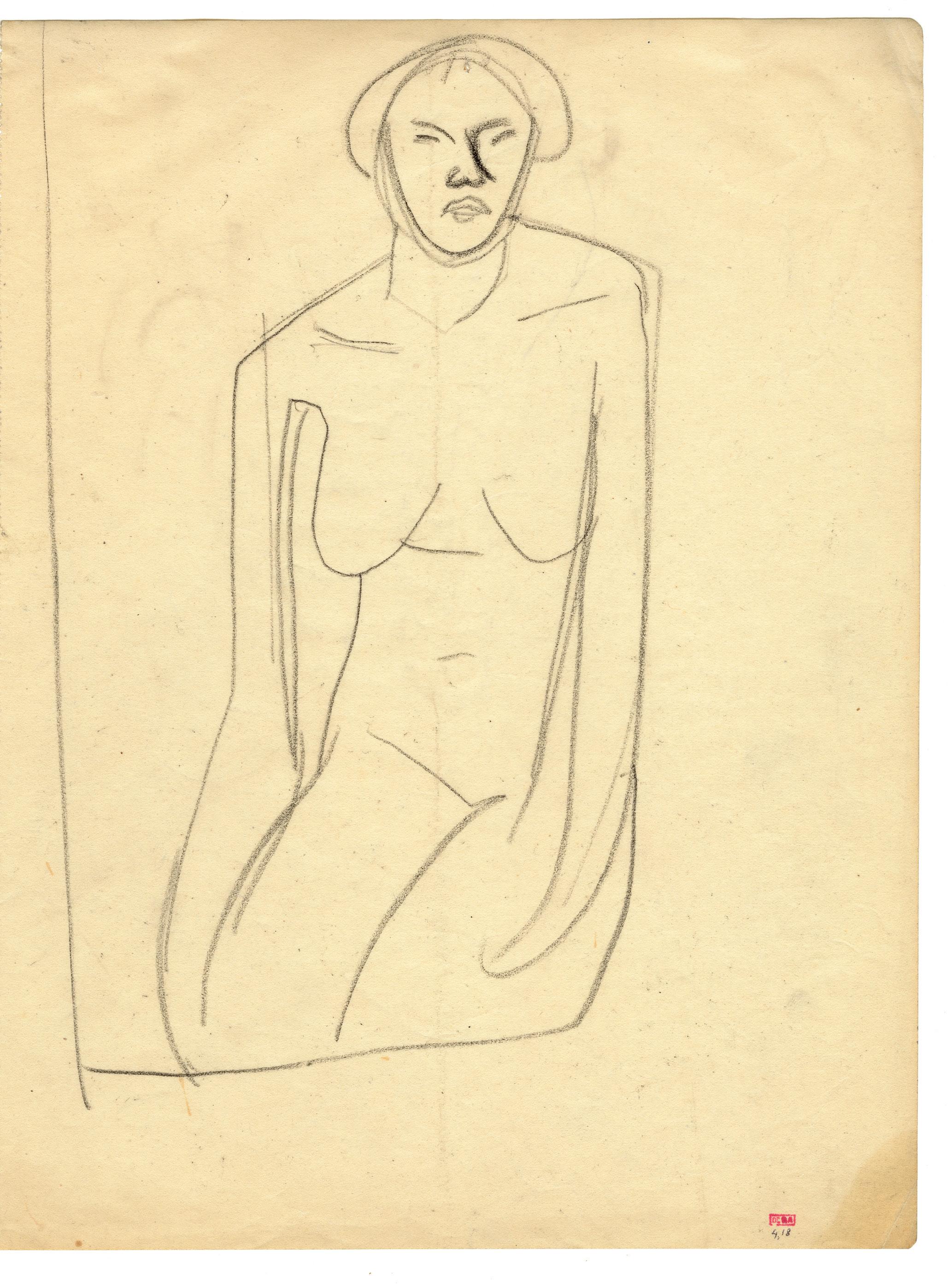
15
6 Amedeo Modigliani 1884 Livorno – Paris 1920
Femme nue s’appuyant sur l’avant-bras gauche
Pencil on wove paper, from a notebook, ca. 1910
With Dr. Paul Alexandre stamp, and the number 86
Sheets 430 x 267 mm
Reference Noël Alexandre, Modigliani inconnu. Témoignages, documents et dessins inédits de l’ancienne collection de Paul Alexandre, 1993, ill. 368, p. 379, cat. 294
Exhibition Modigliani inconnu. Dessins de la Collection Paul Alexandre, 1993-1996; Venice, Palazzo Grassi; London, The Royal Academy of Arts; Cologne, Ludwig Museum; Bruges, Kunstcentrum St. Jan; Tokyo, The Ueno Royal Museum; Lisbon, Culturgest; Madrid, Museo Reina Sofia; Montreal, Musée des Beaux-Arts; Rouen, Musée des Beaux-Arts; Modigliani Unmasked, New York, Jewish Museum, 2017-2018, ill. p. 67
Provenance Dr. Paul Alexandre, Paris (purchased directly from the artist), thence by descent
This mesmerizing drawing, made around 1910, anticipates the famous nudes that Modigliani would paint only a few years later, predicting most of their exemplary characteristics. It also demonstrates the diversity of approaches through which Modigliani would reinterpret an ideal of feminine beauty via his own sensibility. Modigliani’s nudes were to become the talk of the town: In December 1917, when Léopold Zborowski organized a major exhibition of his work at Berthe Weil’s, onlookers flocked to the illuminated gallery. In response to the work’s giddy reception, the police removed four nudes on account of their indecent depiction of visible pubic hair, which daringly bucked academic tradition.
Femme nue s’appuyant sur l’avant-bras gauche has all the characteristics of Modigliani’s great female nudes: the almond-shaped eyes; the liberal exaggeration of certain volumes; an impression of tranquility and sensuality, one deprived of obscenity. One can still sense the artist’s admiration for Cézanne, whose major retrospective he had seen in Paris in 1907. One can also see a certain geometric rigor that Modigliani would have found in the Cubism then being developed by Picasso and Braque. Modigliani’s work as a sculptor
and his admiration for non-European art can also be seen in the woman’s face, which has a gentle, stylized composition, one organized around her elongated nose.
Dr. Paul Alexandre’s collection of Modigliani’s drawings was not made accessible to the public until 1993, when it enabled us to rethink his entire life and œuvre. This nude, like the other drawings from the collection, confirms the visionary words of Jeanne Modigliani: “A glance, alas brief, at the collection of Doctor Alexandre has convinced me that the usual chronological divisions: transitional period marked by the influences of Gauguin, Toulouse-Lautrec, Steinen and Picasso; Cézanne period; sculpture inspired by African art and Brancusi; indecisive and contradictory resumption of painting; fluid and coherent production of the last years, are absolutely arbitrary. The few reliable biographical data available overturn these schemas, and an unprejudiced examination of the works reveals instead the permanence, right up to his death, of certain parallel lines of research” 1 .
1. Jeanne Modigliani, “Modigliani sans légende”, in Amedeo Modigliani. 1884-1920, Musée d’Art moderne de la Ville de Paris, Paris, 1981, pp. 75-76.
16

17
7 Amedeo Modigliani 1884 Livorno – Paris 1920
Tête et épaules de face
Ink on grid paper, from a notebook, ca. 1911-12
With Dr. Paul Alexandre stamp, and the number 32.9; inscribed lower right 4.5
Sheets 210 x 135 mm
Reference Noël Alexandre, Modigliani inconnu. Témoignages, documents et dessins inédits de l’ancienne collection de Paul Alexandre, 1993, ill. 251, p. 293, cat. 173
Exhibition Modigliani inconnu. Dessins de la Collection Paul Alexandre, 1993-1996; Venice, Palazzo Grassi; London, The Royal Academy of Arts; Cologne, Ludwig Museum; Bruges, Kunstcentrum St. Jan; Tokyo, The Ueno Royal Museum; Lisbon, Culturgest; Madrid, Museo Reina Sofia; Montreal, Musée des Beaux-Arts; Rouen, Musée des Beaux-Arts; Modigliani Unmasked , New York, Jewish Museum, 2017-2018, ill. p. 101; Modigliani e l’avventura de Montparnasse, Livorno, Museo della Citta di Livorno, 2019-2020; Modigliani. The Primitivist Revolution, Vienne, Albertina Museum, 2021-2022, cat. 83, p. 148
Provenance Dr. Paul Alexandre, Paris (purchased directly from the artist), thence by descent
To understand one aspect of Modigliani’s artistic originality, one must ponder the secret of these sculptural head drawings, which he pursued as a fixed idea. Modigliani himself had pinned some of these drawings to the walls of his studios, so as to keep them in his periphery over a long period. We know that Modigliani was in search of a certain “plenitude” that would lead him to the creation of sculptures. As he wrote in a letter to Paul Alexandre on 23 April 1913, “Plenitude is approaching. I will do everything in marble.”
This process evolved when he met the sculptor Constantin Brancusi. The two artists had arrived in Paris around the same time and frequented Montparnasse cafés such as La Rotonde, Le Dôme, and La Closerie des Lilas. It is in this same neighborhood that Dr. Paul Alexandre practiced. In 1907, he and his brother Jean rented a dilapidated house in the rue du Delta, where parties and theatrical performances were organised and a colony of artists including Drouard, Brancusi, and Le Fauconnier developed: “Each artist brings his own furniture and works of art, settles there to live without painting or, on the contrary, just comes to work”.1
It was here, around November 1907, that Paul Alexandre met Modigliani, whom he introduced to Brancusi shortly afterwards. Paul Alexandre does not credit Brancusi with Modigliani’s transition from painting to sculpture, as it is popularly thought. Indeed, the two artists never worked in the same studio, though they saw each other often, and Brancusi advised Modigliani on his first forays into three dimensions. Brancusi was
older and more organized, helping the young Italian choose his materials, giving him tips on carving.
The present Tête et épaules de face was produced between 1910 and 1912, in connection with the sculptures he was then designing. By varying components of his geometric constructions, and by accentuating their formal contrasts, Modigliani sought a perfection of balance. He experimented with incorporating strategies learned from African or Khmer art, and he interpreted these precedents with a particular and individual sensitivity.
The elements that compose the faces in these sculptural drawings are based on fundamental geometries: the circle, the oval, the interaction of two curved lines, the rectangle and the triangle. Modigliani often wielded a straight vertical line to represent both the neck of the figures, as well as the median line of their extravagantly elongated noses. These formal features are all present in the Tête et épaules de face, an ink drawing in which the face is inscribed in an almost perfect circle. In their unique approach to figuration, Modigliani’s drawings served an obstinate intelligence that sought ideal beauty in its simplest forms. The more rigorous the symmetry, the greater the freedom Modigliani found in his expression of the essential, as one clearly sees in the strong verticality and frontality of this stunning drawing.
1. Marc Restellini, “Paul Alexandre et l’aventure de la rue du Delta”, in Modigliani: L’ange au visage grave, Paris, Musée du Luxembourg, 2002-2003, p. 97.
18
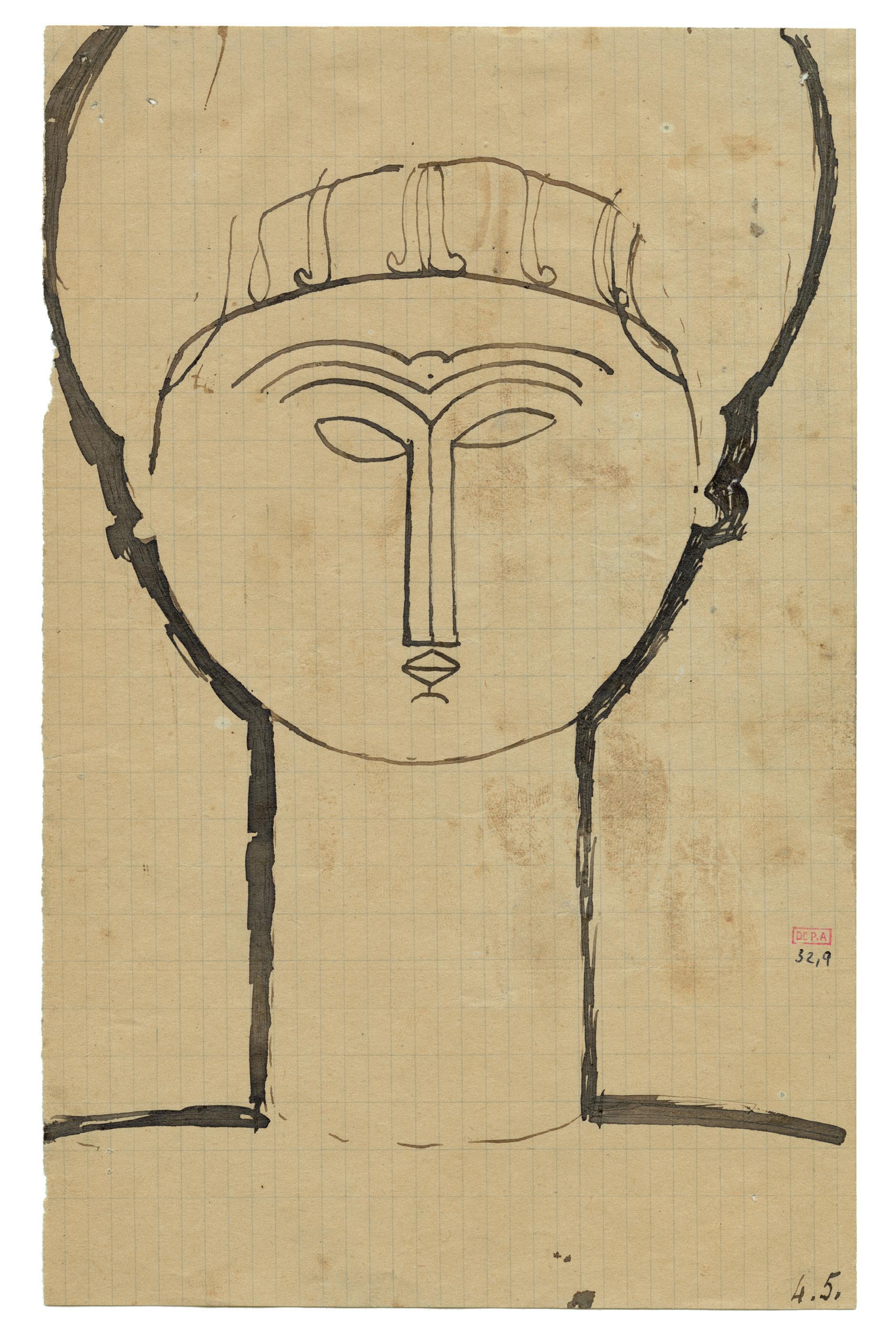
19
8 Amedeo Modigliani
1884 Livorno – Paris 1920
Tête et épaules de face avec frange
Pencil on wove paper from a notebook, ca. 1911-12
With Dr. Paul Alexandre stamp, and the number 23.6
Sheets 427 x 264 mm
Reference Noël Alexandre, Modigliani inconnu. Témoignages, documents et dessins inédits de l’ancienne collection de Paul Alexandre, 1993, ill. 235, p. 283, cat. 123
Exhibition Modigliani inconnu. Dessins de la Collection Paul Alexandre, 1993-1996; Venice, Palazzo Grassi; London, The Royal Academy of Arts; Cologne, Ludwig Museum; Bruges, Kunstcentrum St. Jan; Tokyo, The Ueno Royal Museum; Lisbon, Culturgest; Madrid, Museo Reina Sofia; Montreal, Musée des Beaux-Arts; Rouen, Musée des Beaux-Arts; Modigliani Unmasked, New York, Jewish Museum, 2017-2018, ill. p. 102
Provenance Dr. Paul Alexandre, Paris (purchased directly from the artist), thence by descent
The present work is a fascinating drawing, encapsulating Modigliani’s iconic style and his sculptural vision. Tête et épaules de face avec frange is one of the head drawings that Modigliani made around 1910-13 that were directly connected to sculptures he was designing at the same time. This work offers a powerful insight into his process – one that began by carving out a three-dimensional concept on two-dimensional paper – in search of an ideal beauty.
Modigliani’s vocation as a sculptor arose in parallel to his friendship with Constantin Brancusi, around 1910-14. Some of the essential formal characteristics of Brancusi’s art can be found in Modigliani’s stone heads, caryatids, and busts. As in Brancusi’s Mademoiselle Pogany (1912) and La Muse endormie (1909), Modigliani chose a stylized, hieratic representation for his female head. Her empty eyes form wide, slightly slanted ovals, her nose elegantly joins the line of her superciliary arches, while her mouth remains narrow in the extreme.
Around the same time, he befriended Brancusi, Modigliani, much like Pablo Picasso, Maurice de Vlaminck, and André Derain, discovered so-called “primitive” art soon after arriving in Paris. The Musée d’art ethnique du Trocadéro and the personal collections of his painter friends were full of these highly expressive
sculptures, which wielded simplified forms to powerful effect. Yet it was at the home of Dr. Paul Alexandre, also a collector of African art, that Modigliani discovered the Baule idols and Yaoure masks that would become so important to his own work.
Modigliani’s faces were also highly influenced by the forms used in the Fang masks of Gabon. The small oval eyes found in those sculptures, their long straight noses, and their thin mouths are the essential features that Modigliani retained for his own uses. Amedeo Modigliani was a highly erudite painter. His knowledge of and encounters with Khmer, Cycladic, and Egyptian art also played a major role in shaping his vision.
Modigliani, suffering from tuberculosis, was forced to give up sculpture from 1913 onwards. The various dusts which entered his lungs during carving, as well as the strenuous labor associated with chiseling a piece to completion, compelled Modigliani to end his sculptural production. Yet the portraits he painted in the last years of his life owe much to this experience as a sculptor: “a stage, an asceticism necessary to the maturing of his pictorial personality” 1
1. Jeanne Modigliani, “Modigliani sans légende”, in Amedeo Modigliani. 1884-1920, Musée d’Art moderne de la Ville de Paris, Paris, 1981, p. 79.
20
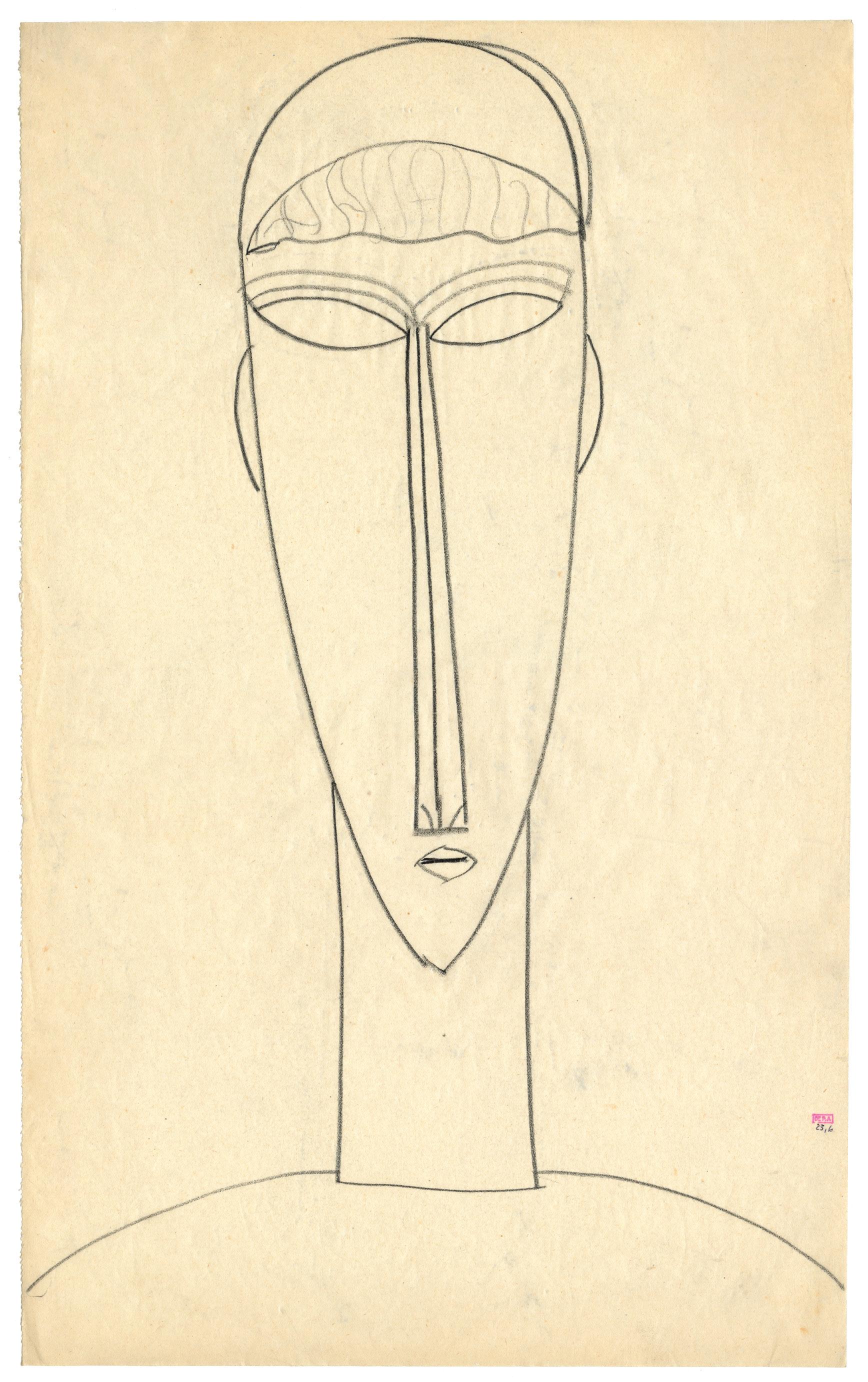
21
9
Homme nu de face, bras écartés
Pencil on wove paper, from a notebook, ca. 1911
With Dr. Paul Alexandre stamp, and the number 17.1
Sheets 428 x 267 mm
Reference Noël Alexandre, Modigliani inconnu. Témoignages, documents et dessins inédits de l’ancienne collection de Paul Alexandre, 1993, ill. 158, p. 231, cat. 201
Exhibition Modigliani inconnu. Dessins de la Collection Paul Alexandre, 1993-1996; Venice, Palazzo Grassi; London, The Royal Academy of Arts; Cologne, Ludwig Museum; Bruges, Kunstcentrum St. Jan; Tokyo, The Ueno Royal Museum; Lisbon, Culturgest; Madrid, Museo Reina Sofia; Montreal, Musée des Beaux-Arts; Rouen, Musée des Beaux-Arts; Modigliani Unmasked , New York, Jewish Museum, 2017-2018; Modigliani. The Primitivist Revolution, Vienne, Albertina Museum, 2021-2022, cat. 3, p. 58
Provenance Dr. Paul Alexandre, Paris (purchased directly from the artist), thence by descent
The present pencil drawing is a rare example of a masculine nude by Modigliani, one expressing a powerful and androgynous presence. Homme nu de face, bras écartés was drawn while Modigliani was producing a series of sculptures between 1910 and 1913. The quantity and the importance of the drawings associated with this body of sculptural work, however, are available to us thanks primarily to Dr. Alexandre’s collection. Together, these drawings show us how Modigliani discovered and incorporated not only the art of Africa, but also the casts and fragments of Khmer sculptures that formed the basis of the Indochinese collection at the Musée du Trocadéro. Modigliani’s fascination with these works, which solved key problems posed by his own aesthetic research, left a clear mark on his art.
Modigliani’s use of the Caryatid motif, which one may see indirectly in this Homme nu de face, bras écartés, was developed between 1911 and 1915 through numerous iterations in pencil, tempera, and watercolour, as well as in an oil on canvas from 1913. His first drawings of caryatids were long and stiff standing nudes, stamped by the influence of archaic Greek art. Modigliani was undoubtedly seduced by those figures, which exist somewhere between the real and the unreal.
His drawings of caryatids, which seek an ideal of expressive freedom as well as the austerity of sculptural geometry, saw Modigliani achieving the fullness of his mature style. Finally, although only one caryatid sculpture by the artist is known – the stone Kneeling Caryatid of 1914 from the collection of the Museum of Modern Art, New York – specialists link many of his caryatid drawings to an unrealized “temple of voluptuousness,” an ambitious plan inspired perhaps by his reading of Lautréamont’s Chants de Maldoror, a copy of which he had sent to Dr. Alexandre.
Homme nu de face, bras écartés is no longer, strictly speaking, a caryatid, but is rather a derivative expression. The pose of the young man, with his hermaphroditic character, is perfectly hieratic from head to chest, but Modigliani introduces to this rigid structure a kind of formal freedom in the man’s hands and legs, whose effect is considerable in relation to their material importance. The artist, renowned for his feminine nudes, incorporates the grace and elegance of a woman’s silhouette into this male nude – offering, through drawing, a richer and more complex expression of masculinity.
22
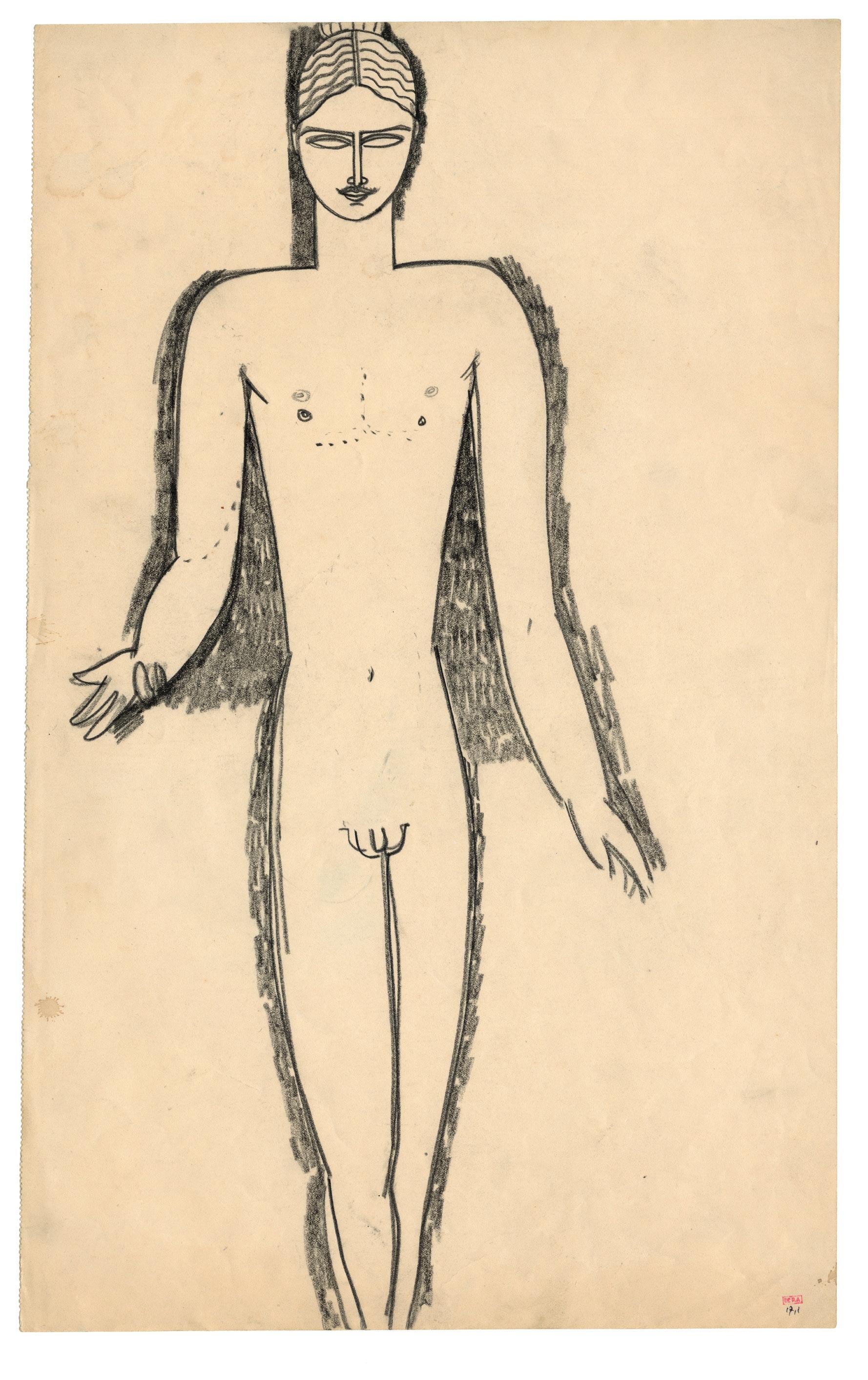
23
Editing
Noémie Goldman
Andrew Shea
Scan & Photographs
Jérôme Allard – Numérisart
Special thanks to (by alphabetical order) Melissa Hughes and her team, Dominique Lejeune and to all of those who have contributed to the publication of this catalogue.
©
entries
Introduction & Catalogue
Gillis
Virginie Devillez Eric
Tia Džamonja
Noémie Goldman Design
Agnews –
2024 Esquisse de femme nue, agenouillée 14 Esquisse de tête et de buste d’une femme 10 Femme nue de face, les mains derrière la tête 8 Femme nue de trois quarts 10 Femme nue s’appuyant sur l’avant-bras gauche 16 Homme nu de face, bras écartés 22 L’Amazone 12 Tête et épaules de face 18 Tête et épaules de face avec frange 20 Index of works
January
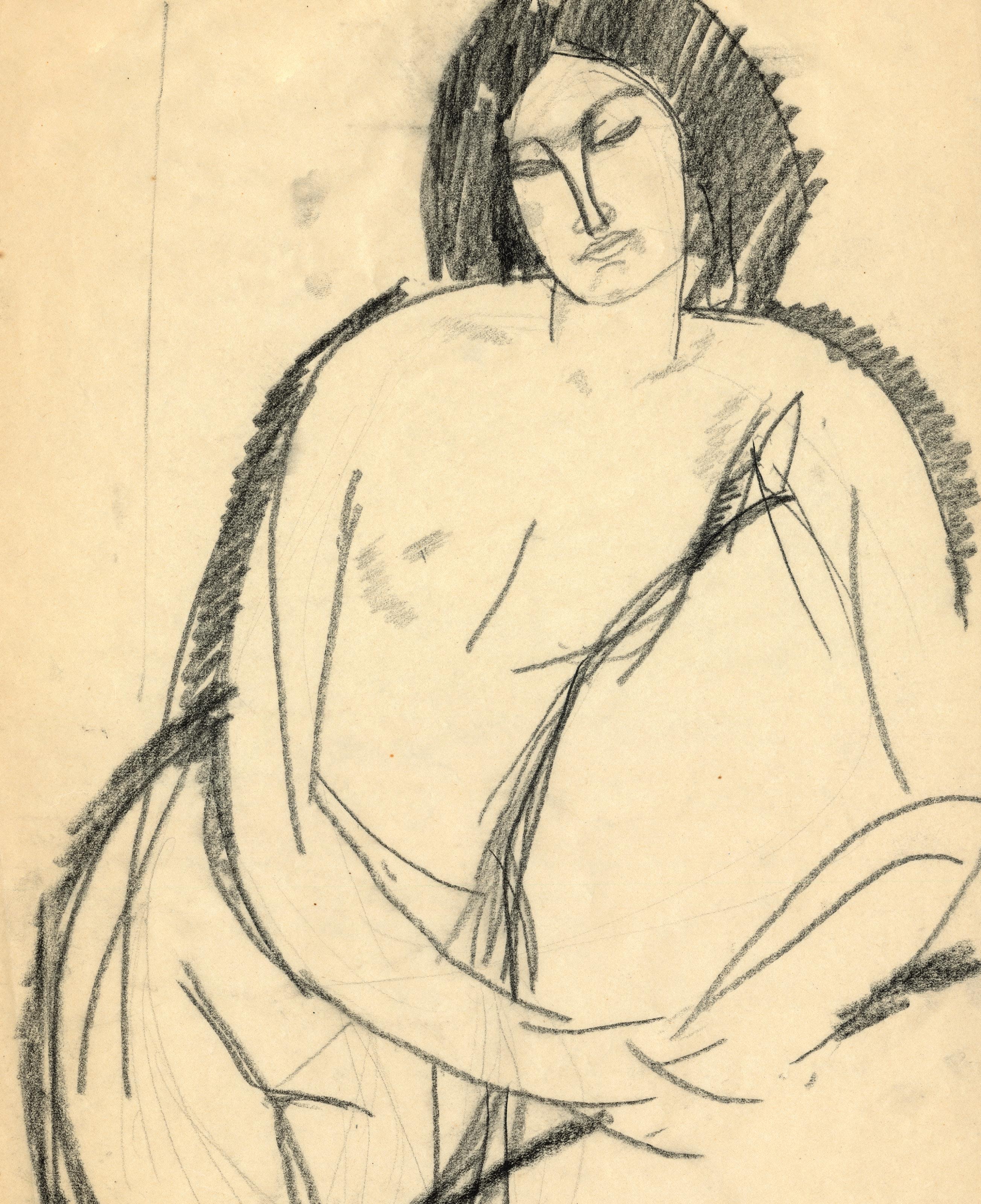
www.agnewsgallery.com London 6 St. James’s Place, London, SW1A 1NP anna@agnewsgallery.com Brussels 1 rue aux Laines, 1000 Brussels noemie@agnewsgallery.com













